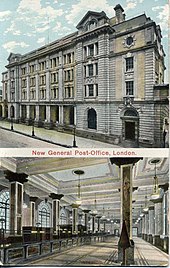
King Edward Building in the City of London was London's main Post Office for most of the 20th century and also the main sorting office for the London EC postal area and for overseas mail. Designed by Sir Henry Tanner, it was opened in 1910 and closed in the 1990s.
The complex had entrances on both King Edward Street and Newgate Street. The 'London Chief Office' on King Edward Street was the largest public post office in the UK.
History
In 1905 King Edward VII laid the foundation stone of a new building for the General Post Office on King Edward Street. Standing opposite the Post Office Headquarters building, which had opened in 1895, King Edward Building was designed to take over the remaining functions of GPO East (the old Post Office headquarters on St. Martin's Le Grand). King Edward Building opened in 1910, after which GPO East was closed and subsequently demolished.

The sizeable new King Edward Building complex was built on what had been the site of Christ's Hospital. It extended back over a considerable area (some 4.5 acres (1.8 ha) including yards and loading bays) from King Edward Street to Giltspur Street. The complex housed the main sorting offices for London (EC district) and for the GPO's Foreign Section, and also served as London's principal public post office. Behind the façade on King Edward Street, the main hall on the ground floor was 'lavishly decorated in marble and bronze' and contained a grand post office counter extending the full length of the room. The floors above were occupied by the offices of the Controller of the London Postal Service, while the basement contained the posting room, into which letters posted through slots in the wall above arrived via chutes, and departed (after preliminary sorting) via a system of conveyors.

Behind the Chief Office on King Edward Street, and connected to it via bridges over loading and unloading yards, stood the large sorting office building (which was likewise designed by Tanner). EC district mail was sorted on the ground floor, and foreign/colonial correspondence on the first floor. In both cases, letters arrived at the east end of the building and progressed through it westwards. The sorting office had its main entrance on Newgate Street, similar in style to the building on King Edward Street. To the west of the sorting office was another yard, from which the mail was dispatched having been sorted into bags; beyond which space was left empty in anticipation of future expansion. (In the course of construction remains of the old London Wall, including a bastion, were discovered here; the bastion was preserved in situ).
Despite its Portland stone and granite facings, the King Edward Building was entirely constructed on the Hennebique system using reinforced concrete, and as such represents a very early example of the use of reinforced concrete for a major public building in the UK.
In 1923 a statue by Edward Onslow Ford of Sir Rowland Hill was set up outside the building on King Edward Street, having been moved from its original location by the Royal Exchange (where it had been erected in 1882). It is inscribed with the words 'He founded uniform penny postage - 1840'.
King Edward Building was one of the original stations on the Post Office Railway, which opened in 1927 to provide a subterranean mail transport link between several different district and sorting offices.
In 1966 the National Postal Museum was established in part of the King Edward Building, and an expanded museum was formally opened there by Queen Elizabeth II in 1969.
The King Edward Building remained in use until the mid-1990s. For much of the century it had offered a counter service 24 hours a day, but it closed to the public in April 1994. For two years it continued to operate as the Royal Mail City and International Office, until July 1996 when these functions were transferred to Mount Pleasant Sorting Office; this left only the Postal Museum on site, until its closure two years later.
In 1997 it was confirmed that the main King Edward Building had been sold to Merrill Lynch & Co., who went on to convert it into their London office. Both sections of the old King Edward's Building (the London Chief Office and the Sorting Office) are Grade II* listed buildings.
See also
References
- ^ Perry, Andrew. "The Post Office & King Edward Building" (PDF). Great Britain Philatelic Society. Retrieved 25 April 2023.
- ^ "Changing Architecture of London's Post Office Quarter". The Postal Museum. Retrieved 25 April 2023.
- ^ "King Edward Buildings Post Office, 106-113 Newgate Street". Historic England. Retrieved 26 April 2023.
- "London Wall: site of Newgate and 121-124 Newgate Street, remains of Roman and medieval wall, gateway and bastion". Historic England. Retrieved 8 May 2023.
- ^ "King Edwards Building (Post Office)". Historic England. Retrieved 26 April 2023.
- "London General Post Office (King Edward Building)". British Post Office Buildings and Their Architects : an Illustrated Guide. Retrieved 26 April 2023.
- "Statue of Rowland Hill". Historic England. Retrieved 26 April 2023.
- Weinreb, Ben; Hibbert, Christopher, eds. (1993). "Post Office". The London Encyclopaedia (2nd ed.). London: Macmillan. p. 634.
51°30′59″N 0°05′56″W / 51.5164°N 0.0989°W / 51.5164; -0.0989
Categories: